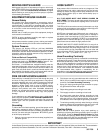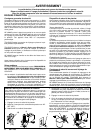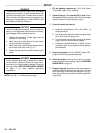
4
307–758
SAFETY
W
ARNINGS
HIGH
PRESSURE SPRA
Y CAN CAUSE SERIOUS INJUR
Y.
FOR PROFESSIONAL USE ONL
Y
. OBSER
VE ALL W
ARNINGS
Read and understand all instruction manuals before operating equipment.
FLUID
INJECTION HAZARD
General Safety
This
equipment generates very high fluid pressure. Spray from
the
gun, leaks or ruptured components can inject fluid through
your
skin and into your body
and cause extremely serious bod
-
ily
injury
, including the need
for amputation. Also, fluid injected
or
splashed into the eyes or
on the skin can cause serious dam
-
age.
NEVER
point the spray gun at anyone or at any part of the body
.
NEVER put hand or fingers over the spray tip. NEVER try to
“blow back” paint; this is NOT an air spray system.
ALWAYS have the tip guard in place on the spray gun when
spraying.
ALWAYS
follow the
Pressure Relief Procedure
, below
, before
cleaning or removing the spray tip or servicing any system
equipment.
NEVER
try to stop or deflect leaks with your hand or body
.
Be
sure equipment safety devices are operating properly before
each
use.
Medical Alert––Airless Spray Wounds
If any fluid appears to penetrate your skin, get EMERGENCY
MEDICAL CARE AT ONCE. DO NOT TREAT AS A SIMPLE
CUT.
T
ell the doctor exactly what fluid was injected.
Note
to Physician
:
Injection into the skin is a traumatic
injury
.
It is important to treat the injury surgically
as
soon as possible.
Do not delay treatment to research toxicity. Toxicity is a
concern with some exotic coatings injected directly into the
blood stream. Consultation with a plastic surgeon or re-
constructive
hand surgeon may be advisable
.
Spray Gun Safety Devices
Be sure all gun safety devices are operating properly before
each
use. Do not remove or modify any part of the gun; this can
cause
a malfunction and result in serious bodily injury
.
Safety Latch
Whenever you stop spraying, even for a moment, always set
the
gun safety latch in
the closed or “safe” position, making the
gun
inoperative. Failure to set the safety latch can result in acci
-
dental
triggering of the gun.
Diffuser
The gun diffuser breaks up spray and reduces the risk of fluid
injection
when the tip is not installed. Check dif
fuser operation
regularly
. Follow the
Pressure Relief Procedure
, below
, then
remove
the spray tip. Aim the gun into a metal pail, holding the
gun
firmly to the pail. Using the lowest possible pressure, trigger
the gun. If the fluid emitted
is not
diffused into an irregular
stream,
replace the dif
fuser immediately
.
Tip Guard
ALWAYS have the tip guard in place on the spray gun while
spraying. The tip guard alerts you to the fluid injection hazard
and
helps reduce, but does not prevent, the
risk of accidentally
placing
your
fingers or any part of your body close to the spray
tip.
Trigger Guard
Always
have the trigger guard in place on the gun when spray
-
ing to reduce the risk of accidentally triggering the gun if it is
dropped
or bumped.
Spray Tip Safety
Use extreme caution when cleaning or changing spray tips. If
the
spray tip clogs while spraying, engage the gun safety latch
immediately. ALWAYS follow the Pressure Relief Procedure
and
then remove the spray tip to clean it.
NEVER
wipe of
f build–up around the spray tip until pressure
is
fully
relieved and the gun safety latch is engaged.
Pressure Relief Procedure
To
reduce the risk of serious bodily injury
, including fluid in
-
jection,
splashing fluid or solvent in the eyes or on the skin,
or injury from moving parts or electric shock, always
follow
this procedure whenever you shut off the sprayer, when
checking
or servicing any part of the spray system, when in
-
stalling,
cleaning or changing
spray tips, and whenever you
stop
spraying.
1.
Engage the gun safety latch.
2.
Turn the ON/OFF switch to OFF.
3.
Unplug the power supply cord.
4.
Disengage
the gun safety latch. Hold a metal part of the
gun
firmly to the side of a
grounded metal pail, and trig
-
ger
the gun to relieve pressure.
5.
Engage the gun safety latch.
6. Open the pressure drain valve, having a container
ready
to catch the drainage. Leave the valve open until
you
are ready to spray again.
If you suspect that the spray tip or hose is completely
clogged,
or that pressure
has not been fully relieved after fol
-
lowing
the steps above,
VER
Y SLOWL
Y loosen the tip guard
retaining
nut or hose end coupling to
relieve pressure gradu
-
ally,
then loosen completely
. Now clear the tip or hose.
1,5
2
4
6
3


















